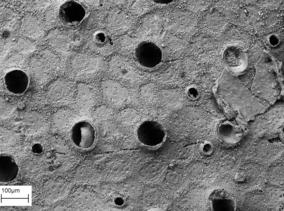You are here
Bryozoa
Semimulticlausa? parasitica (Busk, 1859)
Nomenclature
-
Family: HeteroporidaeGenus: Semimulticlausa
- lectotype: B.M.(N.H.) Palaeont. Dept. D6874
SUMMARY
Colonies are encrusting, multiserial, sheet-like, occasionally giving rise to erect, cylindrical branches. They often encrust on gastropod shells that were probably originally tenanted by hermit crabs. The growing edge of the colony is thin, with the basal lamina extending distally a little way beyond the budding zone. Maculae may be developed that contain a higher than average proportion of kenozooids.
Autozooids are tubular with small, circular or subcircular apertures, about 0.08-0.10 mm in diameter, borne on short peristomes. They lack calcified frontal walls but may be closed by exterior-walled terminal diaphragms with sparsely scattered pseudopores. Autozooidal apertures are spaced widely over the colony surface.
Kenozooids are abundant and occupy most of the colony surface between the autozooids. They are polygonal in surface outline, variable in size, ranging from less than 0.05 mm to almost 0.20 mm in diameter, with thick, slightly salient boundary walls and apertures closed by pseudoporous exterior walls.
Nanozooids are interspersed irregularly among the kenozooids and are approximately as numerous as the autozooids. They have tiny apertures of about 0.03 mm diameter borne on slight perisomes and surrounded by a narrow zone of exterior-walled calcification.
Gonozooids are recognizable as subcircular inflated areas about 1 mm in diameter that lack kenozooids but have a few isolated autozooids supporting a densely pseudoporous brood chamber roof which is fragile and often damaged. The ooeciopore is unknown.





